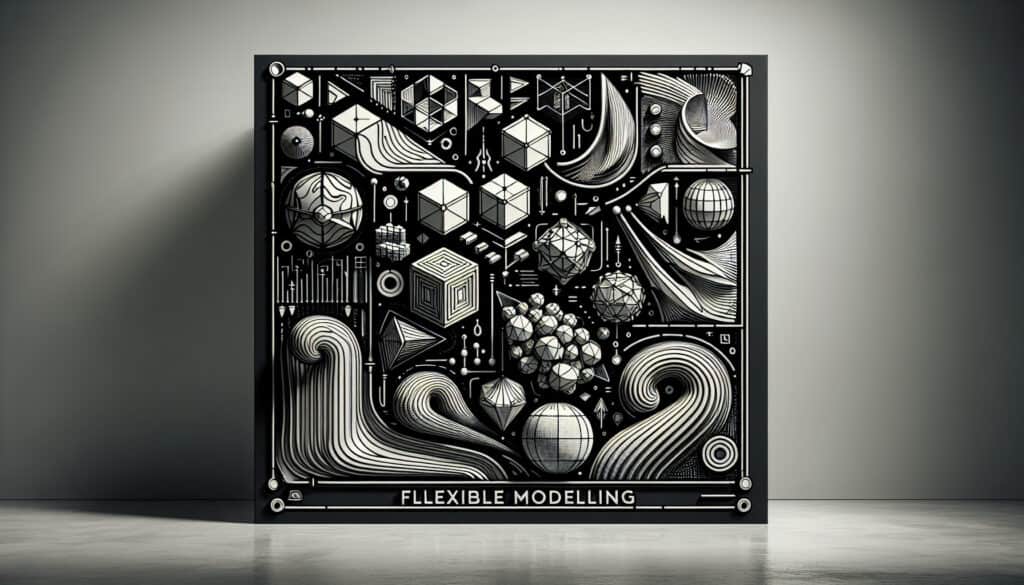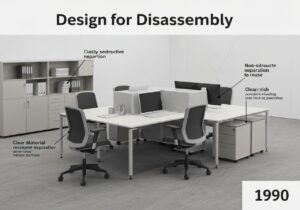Créer et modifier des modèles 3D à l'aide d'une combinaison de techniques de modélisation paramétrique et directe.
- Méthodologies : Ingénierie, Ergonomie
Modélisation flexible

Modélisation flexible
- Méthodologie Agile, Gestion du changement, Computer Aided Design (CAD), Conception pour la fabrication additive (DfAM), Optimisation de la conception, Processus de conception, Développement de produits, Prototypage, Prototypage rapide
Objectif :
Comment il est utilisé :
- A GOUJAT approche de modélisation qui permet aux concepteurs de modifier facilement la géométrie sans être contraints par l'intention originale de la conception. Elle est utile pour apporter des modifications à la conception à un stade avancé et pour travailler avec des données importées.
Avantages
- Permet une flexibilité dans le processus de conception ; permet des modifications rapides de la conception.
Inconvénients
- Peut être moins précis que la modélisation paramétrique ; peut ne pas convenir à tous les types de conception.
Catégories :
- Ingénierie, Conception de Produits
Idéal pour :
- Apporter des modifications de dernière minute à un modèle 3D ou travailler avec des données CAO importées.
La modélisation flexible est particulièrement avantageuse dans les secteurs qui exigent des itérations rapides et une réactivité au retour d'information du client, tels que l'électronique grand public, l'automobile et l'aérospatiale. Dans ces environnements, les ingénieurs et les concepteurs sont souvent confrontés à des modifications tardives liées à la demande du marché ou à l'évaluation de la conception, ce qui rend les méthodes de CAO traditionnelles encombrantes. Grâce à cette approche, les équipes peuvent apporter des modifications à la conception sans perdre l'intention géométrique d'origine, ce qui est particulièrement utile lorsqu'il s'agit de données importées de différents programmes de CAO. Les participants à cette méthodologie comprennent souvent des ingénieurs en mécanique, des concepteurs industriels et des gestionnaires de produits qui collaborent au sein d'équipes interfonctionnelles pour s'assurer que la conception reste alignée sur les fonctionnalités pratiques et les considérations esthétiques. Cette méthodologie est généralement appliquée lors de la phase de prototypage ou au cours de la phase de conception. examen des dessins et modèlespermettant aux parties prenantes de visualiser et d'évaluer efficacement les modifications avant la fabrication finale. L'utilisation de la modélisation flexible permet non seulement d'améliorer les capacités de conception, mais aussi de réduire considérablement le temps nécessaire à la création d'un prototype, ce qui accélère la mise sur le marché tout en améliorant la qualité du produit et la satisfaction du client. Des exemples d'applications peuvent être trouvés dans les produits de consommation personnalisables, où des changements de conception rapides conduisent à de nouvelles fonctionnalités basées sur les commentaires des utilisateurs ou les tendances de la mode qui évoluent rapidement.
Principales étapes de cette méthodologie
- Importer des données CAO ou utiliser des modèles existants.
- Identifier les principales caractéristiques à modifier.
- Utiliser des outils de modélisation basés sur l'historique pour les paramètres modifiables.
- Appliquer des techniques de modélisation directe pour la modification de la géométrie.
- Utilisez la suppression ou l'effacement de caractéristiques pour supprimer les contraintes.
- Réappliquez les contraintes ou appliquez-en de nouvelles si nécessaire.
- Évaluer les changements par des simulations ou des inspections visuelles.
- Affiner la géométrie de manière itérative en fonction du retour d'information.
- Finaliser les modifications et préparer les processus en aval.
Conseils de pro
- Mettre en place un système robuste de gestion des couches dans votre Logiciel de CAO pour isoler et contrôler efficacement les modifications.
- Utiliser les outils de configuration et les tableaux de conception pour les variations de paramètres, ce qui permet d'accélérer les itérations en fonction des exigences du projet.
- Incorporer des pratiques de contrôle des versions pour les données importées afin de suivre les modifications et de maintenir l'intégrité de l'intention originale de la conception.
Lire et comparer plusieurs méthodologies, nous recommandons le
> Référentiel méthodologique étendu <
ainsi que plus de 400 autres méthodologies.
Vos commentaires sur cette méthodologie ou des informations supplémentaires sont les bienvenus sur le site web de la Commission européenne. section des commentaires ci-dessous ↓ , ainsi que toute idée ou lien en rapport avec l'ingénierie.
Contexte historique
1980
1980
1986
1987
1990
1990
1990
1980
1980
1986
1986
1987-03
1990
1990
1992
(si la date est inconnue ou n'est pas pertinente, par exemple "mécanique des fluides", une estimation arrondie de son émergence notable est fournie)















Articles Similaires
Simulation de Monte Carlo
Tests basés sur des modèles
Contrôle des modèles
Recherche sur les méthodes mixtes
À l'épreuve des erreurs (Poka-Yoke)
Test du profil de la mission